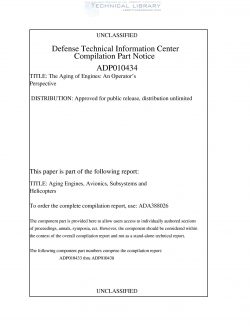DTIC-AD-P010434
- Version
- 229 Downloads
- 3.93 MB File Size
- 1 File Count
- March 5, 2017 Create Date
- March 5, 2017 Last Updated
The Aging of Engines; An Operators Perspective

ABSTRACT NATO countries are currently faced with the need to operate fleets of mature gas turbine engines built many years ago. Because of diminishing resources for new equipment, the prospects of replacing these engines with new ones are not good at present. How long such engines can be kept in service safely, without replacing a significant portion of their aging structural components has become a growing concern to engine life-cycle managers, due to uncertainties in residual lives. Another concern is the high maintenance cost associated with the replacement of durability-critical components, such as blades and vanes. The need to balance risk and escalating maintenance costs explains the growing interest in the application of life extension technologies for safely extracting maximum usage out of life-limited pans. In the case of aero-engines, maintaining airworthiness while ensuring affordability is of prime concern to both life- cycle Inanagers and regulatory authorities. This lecture describes the modes of deterioration of engine components and discusses their effects on the performance, operating costs, reliability and operational safety of engines. It also identifies component life extension strategies that engine life-cycle managers may adopt to cost-effectively manage their engines, while ensuring reliability and safety. A qualification methodology for component life extension, developed and implemented for Canadian Forces engines, is presented. The methodology incorporates an Engine Repair Structural Integrity Program (ERSIP) that was conceived to establish structural performance requirements and identify tests for development and qualification of life extension technologies, to ensure structural integrity and performance throughout the extended life. Examples of life extension technologies applied to gas path components and critical rotating parts are described, including the use of protective coatings and repairs to increase component durability. The application of damage tolerance concepts to allow use of safety-critical parts beyond their conventional safe-life limits is also illustrated.
| File | Action |
|---|---|
| DTIC-AD-P010434 The Aging of Engines; An Operators Perspective.pdf | Download |

Comment On This Post